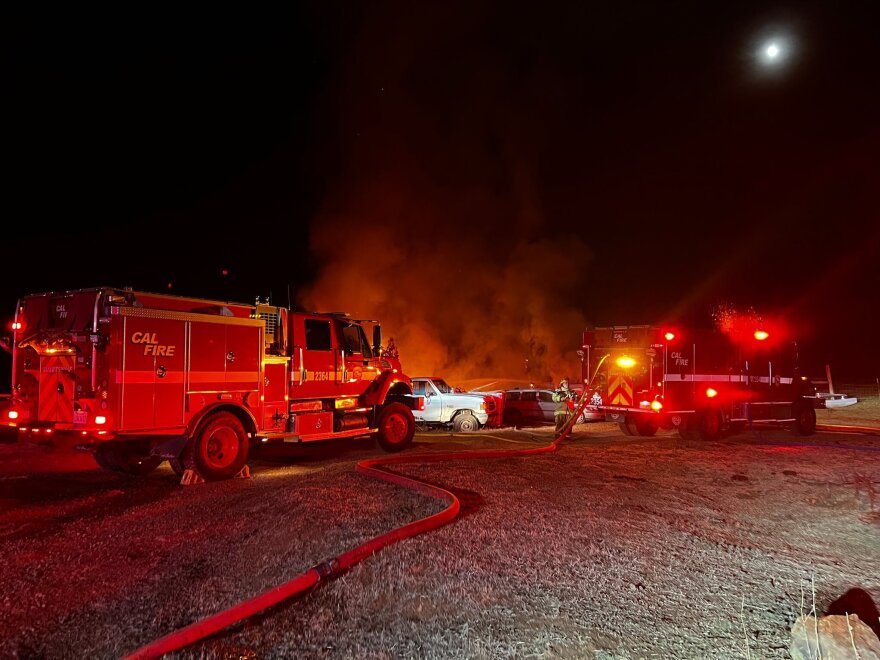A "flaming basketball" meteor in the sky recently made headlines after claims that it struck a home in northern California and set it on fire.
The house, which sits on a cattle ranch in Nevada County, about 60 miles from Sacramento, was destroyed. Its owner, Dustin Procita, was left rattled by the seemingly freakish accident.
Local eyewitnesses took to the internet, spreading images and video of a bright yellowish light in the sky, careening toward earth. Neighbors told arriving firefighters that they had heard a thunderous crash at about the same time as the blaze is believed to have begun.
"They said it's a 1 in 4 trillion chance," Procita exclaimed to local news reporters, hours after the 800-square-foot home was reduced to ashes.
Turns out Procita may have been unlucky, but not that unlucky.
Yeah, caught it on my dashcam as well. pic.twitter.com/1L3kZH05sG
— Jason Berry (@jberry7777) November 5, 2022
The cold hard truth about falling meteorites
Scientists who track meteorites are skeptical that this tragedy was caused by a falling rock from outer space.
In fact, Peter Jenniskens, a meteor astronomer with the SETI Institute in Mountain View, Calif., told NPR that by the time a meteorite would have hit Earth, there was probably not much left of the falling rock – likely a rogue piece of the Southern Taurid meteor shower that is famous for producing the brightest fireballs during the month of October.
A part of Jenniskens' job is to find meteorites. To do that, he often uses Doppler weather radar to track their descent. Meteorites can fall into the earth's atmosphere anywhere from 20 to 33 kilometers per second. They travel so quickly that the heat and friction cause the fragments to break apart or melt away, leaving very little to study, he explained.
Sometimes larger bits actually make it through, hitting land or water.
"But in this case, it probably did not," he said, adding that he was confident in the conclusion based on data gathered by Doppler weather radar sweeps of the area.
The weather radar often picks up the sound of falling rock, mistaking it for hail, according to Jenniskens. "And in this case, that was not seen. So we don't think that enough material survived for the radar to get a signal."
He also noted that based on his team's calculations, the fireball that eyewitnesses saw up in the sky would have landed about 37 kilometers – nearly 23 miles – away from Procita's home.
"To most people looking up they look like they're really close. But they're not," Jenniskens said.
In this case, 120 eyewitnesses from as far north as Grants Pass, Ore., to as far south as Greenfield, Calif., a stretch of more than 500 miles, reported seeing the streaking meteor.
Finally, Jenniskens added, falling space debris does not start fires on the ground. Yes, they're called fireballs because they illuminate the sky, but they're never actually emitting flames, he said.
"I don't think it could have set [the house] on fire because the rock would just not be hot enough. It would have had time to cool down on its descent," Jenniskens said.
When they finally hit the ground, he said, "they land cold."
Famous outer space rocks
One of the more famous of these extraterrestrial rock incidents occurred in 2010, when a half-pound meteorite struck a doctor's office in Virgina at up to 200 miles per hour.
"It went through the roof. It [went] through one wall partition and then passed through a particle board ceiling into the floor of an examination room," Linda Welzenbach, manager of the meteorite collection at the Smithsonian National Museum of Natural History, told Space.com at the time.
More recently, a dog house that was hit by a meteorite in 2019 fetched more than $44,000 at a Christie's auction in New York. At the same sale, the actual rock that pierced a hole in the metal kennel sold for more than $21,000.
Coincidence does not equate to causation
Fire Capt. Clayton Thomas, who is leading the investigation into the fire at Procita's home in Nevada County, said that by the time the first fire team arrived at the house, "it was fully engulfed in fire."
Even as firefighters were battling the blaze, other people in the area told the incident commander that they had seen "some type of flaming object fall to the ground," Thomas told NPR.
He noted that Nov. 4 – the night of the fire – was the peak of the Southern Taurid meteor shower that was putting on a spectacular show over northern California. He said in nearly all of the reports received by the fire department, "people felt it had fallen right in this vicinity."
That included Procita. "The resident and one of his neighbors nearby heard a loud crash, and when he walked out to the front of the building, the porch was on fire."
Procita managed to save one pet dog from the flames and tried to get back inside for a second, but couldn't save him. The dog died in the fire, according to Thomas.
While the investigation continues, he said, he's not dismissing the outer-space-rock theory but he's looking at more typical causes for residential fires, including electric issues, a possible gas leak or smoking material.
A true believer in the scientific method, Thomas said, "There is a coincidence that there was a loud noise audible to several people in the neighborhood at the time of the fire. And there was a meteor shower and there were people who witnessed something bright falling from the sky right about the same time."
"But coincidence does not equate to causation."
Copyright 2022 NPR. To see more, visit https://www.npr.org.



